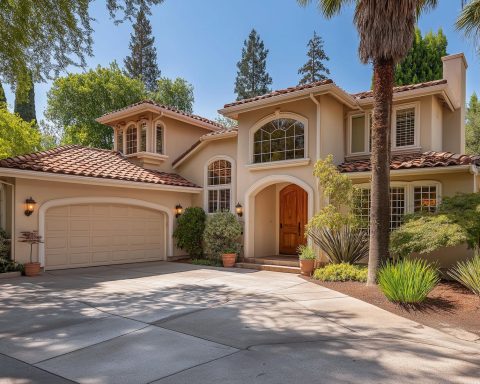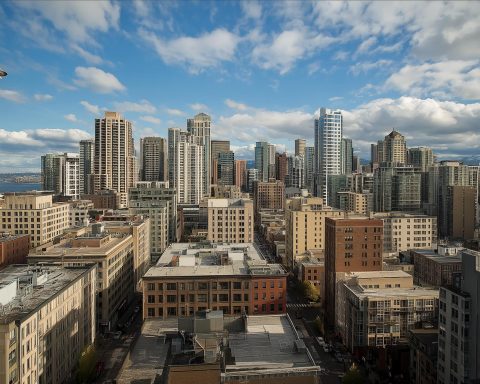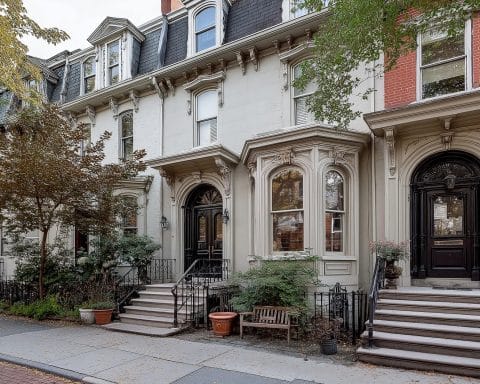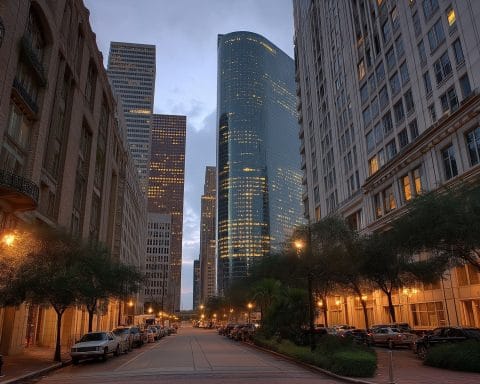The Edinburgh real estate market in 2025 is showing resilience and steady growth, outperforming many other UK regions. Residential property prices are rising modestly amid high demand and limited supply, while the rental sector is stabilizing after a period of rapid rent increases. Commercial real estate – especially offices – is benefiting from strong occupier demand and constrained supply, driving rents upward. This comprehensive report examines Edinburgh’s residential and commercial property trends, current and projected prices, rental yields, key neighborhoods, economic drivers, and policy developments shaping the market in 2025 and beyond.
Residential Market Trends in Edinburgh (2025)
Edinburgh’s housing market remains robust in 2025, characterized by healthy buyer demand, low supply, and modest price growth. Sales activity picked up strongly from 2024 into early 2025, defying some predictions of a downturn simpsonmarwick.com. According to Scottish Government data, housing transactions in Scotland rose 5.4% in 2024 versus 2023 forum.caithness.org, reflecting renewed confidence. In Edinburgh, buyer demand has been buoyed by improving affordability as mortgage rates start to ease (more on interest rates below). Low unemployment and rising incomes are supporting homebuyer confidence simpsonmarwick.com umega.co.uk, and the population growth in the city (about 7.7% projected increase 2018–2030) ensures a steady stream of demand edinburghhsc.scot.
Home prices are on a gentle upward trajectory rather than a boom. The average Edinburgh house price was around £291,000 in April 2025, up 6.1% year-on-year ons.gov.uk ons.gov.uk. This annual growth outpaced Scotland’s overall 5.8% rise, indicating Edinburgh’s market is slightly stronger than the national average ons.gov.uk. For context, across the UK the average house sold for £265,000 in the same period ons.gov.uk. Notably, larger homes have seen the strongest appreciation – the average price for detached houses in Edinburgh jumped 11.1% in the past year, reflecting high demand for family homes and more space ons.gov.uk. By contrast, flat prices rose around 4–6% annually ons.gov.uk, showing steady but more modest growth.
Supply remains tight. New listings have increased only slightly, and available inventory remains low relative to buyer demand. ESPC (Edinburgh Solicitors Property Centre) reports that new property listings in Edinburgh and surrounding areas were up 4.8% annually in spring 2025, but sales volumes still slightly declined (−1.3% year-on-year) espc.com. Homes are selling quickly – the median time to sell is about 3–4 weeks (27 days), only a day slower than a year ago espc.com – and many properties still attract competitive bidding. On average, properties achieved 101.5% of Home Report valuation in early 2025, meaning most homes sell for slightly above their appraised value espc.com. This is a tad lower than last year (when it was ~103%), suggesting price gains are becoming more moderate espc.com. Around 20% of listings go to a closing date (sealed bids), indicating continued competition for the most sought-after properties espc.com.
Regional differences persist within Edinburgh. Prime central neighborhoods are seeing solid price appreciation, while some outer areas remain relatively affordable. For example, Edinburgh City Centre (New Town, Old Town, Stockbridge, West End) saw prices climb +8.4% year-on-year as of spring 2025, reaching an average of about £341,000 espc.com. In contrast, some suburban or neighboring markets have slower growth or slight dips – e.g. East Lothian’s average price ticked down 1.7% over the year espc.com. Overall, however, most areas in and around Edinburgh are experiencing price increases espc.com. The city of Edinburgh remains the most expensive region in eastern Scotland with an average price around £300k, whereas areas like West Fife & Kinross average ~£216k espc.com.
Buyer demographics are shifting slightly. First-time buyers have become more active as lending conditions improve – they made up roughly 36% of transactions in Edinburgh recently, higher than previous years investropa.com. Many are taking advantage of slightly lower mortgage rates and the relative affordability of flats. In fact, the average price paid by first-time buyers in Edinburgh was £244,000 in April 2025 ons.gov.uk. At the same time, some buy-to-let investors have pulled back due to tax changes (more on that under policy risks), which is allowing more properties to be bought by owner-occupiers investropa.com investropa.com. Overall, the residential market in Edinburgh is stable and competitive, with incremental price gains rather than any overheating – a consensus view is that 2025 will be a year of “strong but steady” growth simpsonmarwick.com.
Commercial Real Estate Trends in 2025
The commercial property sector in Edinburgh is led by a strong office market in 2025, while retail and industrial segments show mixed performance. Office space demand has proven resilient: Edinburgh started the year with robust leasing activity, and Q1 2025 office take-up was over 25% higher than Q1 2024 scotsman.com. Around 92,000 sq ft of city-centre office space was leased in the first quarter (33 deals versus 26 a year prior) scotsman.com scotsman.com, driven chiefly by the technology, telecom, and professional services sectors which each accounted for ~15% of space transacted scotsman.com. This rebound suggests companies are actively seeking quality workspace as the economy stabilizes and as flexible/hybrid working patterns settle.
A defining feature of Edinburgh’s office market is limited supply, especially of Grade A space. Vacancy rates for new or prime Grade A offices are extremely low – about 0.37% in the city centre – essentially full occupancy of top-tier offices scotsman.com. Even across all grades, the vacancy is only ~6.7%, down from over 9% a year earlier scotsman.com knightfrank.co.uk, indicating tightening supply. Crucially, almost no new office developments are slated for completion in the next couple of years, meaning tenants have few options for large, modern spaces scotsman.com. (There is roughly 882,000 sq ft of potential refurbishments in the medium-term pipeline, but nothing imminent scotsman.com.) This supply squeeze is putting upward pressure on prime office rents, as occupiers compete for limited high-quality space scotsman.com scotsman.com. Prime headline office rents in Edinburgh were around £45–46.50 per sq ft at end of 2024 knightfrank.co.uk and are expected to continue rising through 2025 given the demand-supply imbalance.
Office investment has been cautious but steady – prime yields are in the mid-6% range (around 6.5% for city centre offices knightfrank.co.uk), making Edinburgh offices attractive relative to many other UK cities. In the last 6 months of 2024, about £120m of Edinburgh offices changed hands, reflecting investor interest in well-let properties despite higher interest rates cuthbertwhite.com. With rates now easing, investor sentiment in 2025 may improve further for Edinburgh’s office assets.
In the retail sector, Edinburgh’s prime retail core (such as the new St James Quarter and traditional shopping streets Princes Street/George Street) is gradually recovering post-pandemic with help from returning tourists and the city’s growing population. However, structural challenges from e-commerce persist. Retail rents and footfall in prime locations have stabilized, but secondary retail remains softer. The hospitality and leisure property segment is buoyant thanks to Edinburgh’s tourism (over 4 million visitors a year pre-pandemic edinburgh.gov.uk) – hotel occupancy and new hotel development in the city continue to be strong, and pub/restaurant spaces see solid demand.
Meanwhile, industrial and logistics properties around Edinburgh benefit from the surge in ecommerce and the city’s economic growth. There is healthy demand for warehouses and distribution hubs on the city outskirts (e.g., Newbridge, Sighthill areas), but supply is limited here too. This has led to rising industrial rents and low vacancy for good industrial units. Additionally, life-sciences and tech incubator spaces (for example at the Edinburgh BioQuarter and University-linked innovation centers) are expanding, reflecting Edinburgh’s growing role in tech and biotech – a trend supporting niche commercial real estate development.
Overall, Edinburgh’s commercial real estate in 2025 is defined by strong occupier demand and constrained supply in key segments. Offices are a standout: “prime rents are rising amid a restricted development pipeline”, as one property agency noted scotsman.com. Investors and occupiers alike remain optimistic on Edinburgh in the long term due to its diverse economy and status as Scotland’s capital, though the latter half of 2025 could see slower commercial activity if broader economic headwinds pick up scotsman.com scotsman.com.
Current Property Prices and Forecasts
Average Prices in 2025
Property values in Edinburgh have reached record highs in 2025, with growth moderating to sustainable levels. According to the UK House Price Index, the average house price in Edinburgh city is around £290,000–£300,000 in early 2025 ons.gov.uk espc.com. This makes Edinburgh the second-highest priced market in Scotland (after some exclusive suburban counties) and well above the Scottish average (~£191,000) ons.gov.uk. Within the city, prices vary by property type:
| Property Type | Avg. Price (Edinburgh, Apr 2025) | Annual Change (Apr 2025) |
|---|---|---|
| Detached House | £676,000 ons.gov.uk | +11.1% YoY ons.gov.uk (high demand for family homes) |
| Semi-Detached | £434,000 ons.gov.uk | – (steady growth, mid-range segment) |
| Terraced House | £365,000 ons.gov.uk | – (strong demand in popular neighborhoods) |
| Flat / Apartment | £237,000 ons.gov.uk | +4.2% YoY ons.gov.uk (more modest growth) |
Table: Average Edinburgh house prices by property type, and annual price change to April 2025. Source: Registers of Scotland/ONS ons.gov.uk ons.gov.uk.
These figures illustrate how larger homes command a premium in Edinburgh – detached houses average well over half a million pounds, reflecting limited supply of these in the city. Flats, which form a large portion of Edinburgh’s housing stock (from tenement apartments to modern condos), average around £230k. It’s worth noting that “prime” properties in the best areas often far exceed these averages; for instance, prime Edinburgh City properties (the top tier of the market) have an average around £518,000 according to Savills, although prime prices were essentially flat year-on-year in early 2025 savills.co.uk. At the other end, Edinburgh still offers relatively affordable options in certain districts or for smaller units – one-bedroom starter flats in areas like Gorgie or Leith can be found around £150k–£180k investropa.com.
Projected Price Growth (2025–2027)
Forecasts for Edinburgh’s property prices over the next few years are broadly positive, though most analysts expect moderate growth rather than rapid spikes. Multiple property consultancies and agencies have released projections:
- 2025 Full-Year: Edinburgh house prices are forecast to rise about 3% to 5% during 2025, building on the gains seen in early 2025 investropa.com. Local Edinburgh agent Umega projects up to +5% for the year, whereas Hamptons (a national agency) forecasts around +3%, citing economic headwinds investropa.com. The consensus is that Edinburgh will outperform the UK average (the UK market is relatively flat) due to the city’s strong fundamentals.
- 2026: Looking further ahead, continued growth is expected in 2026 but at a gradual pace. Savills forecasts Edinburgh prices could be 10–12% higher by mid-2028 compared to now investropa.com. This implies annual growth on the order of 3–4% per year for the next 3–4 years. In other words, the trend is steady upward, roughly keeping in line with inflation and wage growth, rather than a boom. By end of 2026, the average house price in Edinburgh might be in the £310k–£320k range if these growth rates materialize.
- 2027 and beyond: The general outlook remains cautiously optimistic. Continued low housing supply, population growth, and an improving economy are expected to support prices. However, analysts also caution that affordability constraints will cap excessive growth – if house prices rise much faster than incomes, demand could soften investropa.com. Thus, forecasts beyond 2026 often assume growth will temper. Many experts foresee mid-single-digit percentage annual increases through 2027, barring any major shocks.
Key factors behind these projections include: interest rates trending down (improving buying power), Edinburgh’s strong job market, chronic housing supply shortages, and the city’s lasting appeal to both domestic and international buyers investropa.com. There are downside risks (e.g. if inflation or rates don’t fall as expected), but at this stage no major price corrections are anticipated in Edinburgh. Notably, Scotland’s market has been more resilient than England’s recently – a RICS survey in Q1 2025 showed a net balance of +34% of Scottish surveyors reporting price rises (versus almost flat for UK overall) simpsonmarwick.com. Edinburgh, as the nation’s economic hub, is central to that resilience.
In summary, home values in Edinburgh are expected to keep climbing gradually over the next few years, extending the post-pandemic uptrend. By around 2027, average prices could be roughly 10–15% higher than today, assuming forecasts hold. While double-digit annual jumps seem unlikely, Edinburgh’s property market should continue delivering stable growth, underpinned by enduring demand and constrained supply. Investors and homeowners can therefore anticipate reasonable capital appreciation in the medium term.
Rental Market: Yields and Demand Patterns
Edinburgh’s private rental sector has undergone a notable shift entering 2025. After several years of surging rents due to housing shortages, the market is now moderating as supply improves. Average rents in Edinburgh remain high in absolute terms, but rent inflation has cooled from double-digit peaks to more normal levels, much to the relief of tenants propertybeeinvestments.com propertybeeinvestments.com.
According to the ONS, the average monthly rent in the broader Lothian area (which includes Edinburgh) was £1,407 as of May 2025, up 4.6% year-on-year ons.gov.uk. This is similar to the Scotland-wide rent increase (~5%) and a marked slowdown from the >10% annual rent hikes seen in 2022. In Edinburgh city alone, new rentals coming to market in Q1 2025 showed only a ~1–2% annual rent increase on average citylets.co.uk. For example, Citylets data for Q1 2025 show a 1-bed flat in Edinburgh averages £1,055 per month (+1.9% YoY), and a 2-bed flat ~£1,402 (+1.2% YoY) citylets.co.uk. Larger units saw similarly modest rises (3-beds £1,935, +2.1%). Essentially, rent growth has normalized to low single digits after an exceptional period in 2021–2023.
Rental demand in Edinburgh is still strong, but the key change is on the supply side: more properties are available to rent now than in recent years. By late 2024, the number of homes for rent on portals exceeded 1,000 (a threshold not crossed in the prior three years) as landlords brought more units to market propertybeeinvestments.com. In fact, between September 2024 and January 2025 there was a 35% surge in new rental listings in Edinburgh propertybeeinvestments.com. This influx of supply – partly due to some short-term rentals converting to long-term and homeowners opting to let out properties – has given renters more choice. Concurrently, tenant enquiries have stabilized, meaning the market is less frenzied than before propertybeeinvestments.com. Many leasing agents report a return to seasonal patterns (with the summer peak still ahead) instead of the year-round scramble seen at the height of the supply crunch propertybeeinvestments.com.
With supply-demand finding better balance, renters have gained some bargaining power in 2025. It’s now common for well-informed tenants to negotiate or at least have multiple options, which was rare a year or two ago. The average time to let a property in Edinburgh has lengthened slightly – now about 33 days on market (median), which is 5 days slower than a year prior citylets.co.uk. Still, more than half of rentals are snapped up within a month, and about 13% are leased within one week, so desirable rentals move fast citylets.co.uk. The slight slowdown simply reflects that landlords can no longer name any price – rent increases have cooled to a sustainable pace of ~5% or less propertybeeinvestments.com. Notably, Zoopla’s index showed Edinburgh’s annual rent inflation at 4.8% in late 2024, down from ~14% the year before propertybeeinvestments.com. This “cooling” is considered a healthy correction for the market propertybeeinvestments.com.
For landlords and investors, Edinburgh’s rental yields have become quite attractive thanks to the earlier rent rises combined with the recent slower house price growth. Even with rents stabilizing, the gross rental yields in many Edinburgh postcodes are around 6% or higher, which is strong for a major UK city propertybeeinvestments.com. A joint analysis by ESPC and Citylets identified the top rental yield areas in Edinburgh for Q1 2025:
| Area (Postcode) | 1-Bed Yield | 2-Bed Yield | 3-Bed Yield |
|---|---|---|---|
| City Centre – EH3 (New Town, West End) | 6.8% propertyinvestortoday.co.uk | 5.6% propertyinvestortoday.co.uk | 5.4% propertyinvestortoday.co.uk |
| Leith – EH6 (northeast waterfront) | 6.3% propertyinvestortoday.co.uk | 5.7% propertyinvestortoday.co.uk | 6.7% propertyinvestortoday.co.uk |
| Newington/Abbeyhill – EH8 (south/east central) | 6.4% propertyinvestortoday.co.uk | 6.5% propertyinvestortoday.co.uk | 6.8% propertyinvestortoday.co.uk |
| Gorgie/Dalry – EH11 (west-central) | 6.4% propertyinvestortoday.co.uk | 6.5% propertyinvestortoday.co.uk | 6.8% propertyinvestortoday.co.uk |
| Corstorphine – EH12 (west Edinburgh suburbs) | 7.1% propertyinvestortoday.co.uk | 6.6% propertyinvestortoday.co.uk | 5.4% propertyinvestortoday.co.uk |
| (Highest single yield:) Old Town – EH1 (3-bed flats) | – | – | 7.3% propertyinvestortoday.co.uk |
Table: Gross rental yields by area and property size in Edinburgh, Q1 2025. Source: ESPC/Citylets data propertyinvestortoday.co.uk propertyinvestortoday.co.uk.
As shown above, many central areas are generating 6-7% yields, which is excellent given Edinburgh’s historically lower yields (~4-5% pre-2020). Notably, one-bed flats often yield around 6-7% in these areas, as their lower purchase prices relative to rent make for efficient investments propertyinvestortoday.co.uk. Areas like EH12 (Corstorphine) even saw one-bed yields above 7%, benefiting from moderate entry prices and steady tenant demand propertyinvestortoday.co.uk. Interestingly, a new trend in early 2025 is larger flats yielding strongly – three-bedroom rentals outperformed in several areas (EH6, EH8, EH11 all saw ~6.7–6.8% for 3-beds) propertyinvestortoday.co.uk propertyinvestortoday.co.uk. ESPC notes this may reflect more families entering the rental market, driving up demand (and rents) for bigger homes propertyinvestortoday.co.uk propertyinvestortoday.co.uk. Indeed, agents observe that while young professionals and students still dominate rental demand, family renters are becoming more common, a shift from the past when family housing was mostly for sale market propertyinvestortoday.co.uk.
Rental demand drivers: Edinburgh’s rental market draws from a large student population (the city’s universities attract tens of thousands of students), young professionals in finance/tech sectors, and an increasing number of relocating families and international workers. The city’s quality of life and job opportunities mean there is a constant flow of tenants. Even as some tenants leave to become first-time buyers (taking advantage of improved mortgage conditions), new renters arrive, keeping occupancy rates high.
In summary, Edinburgh’s rental sector in 2025 is healthier and more balanced than a year ago. Tenants benefit from the slower rent increases and a bit more choice, while landlords still enjoy solid yields and low vacancy. Rental hotspots like Leith and Gorgie continue to deliver strong returns, and overall average yields above 6% are “comfortably” achievable in central Edinburgh propertybeeinvestments.com. The outlook is for rents to keep rising, but at a controlled pace in line with wage growth. If anything, the recent policy changes (like rent caps and high landlord taxes) have prompted some landlords to sell, but many remaining landlords are seeing better yields on their investment now than in the past, which could entice new buy-to-let investors back into the Edinburgh market as the regulatory situation clarifies propertyinvestortoday.co.uk.
Key Neighborhoods to Watch in Edinburgh
Edinburgh is a city of diverse neighborhoods, each with its own property market dynamics. Some areas are experiencing rapid growth or regeneration, while others offer especially strong investment fundamentals. Here are key neighborhoods to watch for real estate in 2025 and the coming years:
- Leith (EH6) – Waterfront Revival & Trendy Lifestyle: Leith has transformed from a historic port into one of Edinburgh’s hottest property markets. Waterfront regeneration projects and the 2023 tram line extension to Newhaven have dramatically boosted Leith’s appeal investropa.com investropa.com. Property prices in Leith have surged ~17% in recent years investropa.com, yet the area remains more affordable than the city center, drawing first-time buyers and creative professionals. A £1.3 billion investment in the nearby Granton Waterfront development is further enhancing infrastructure and sustainability in Leith investropa.com. The mix of modern flats, converted warehouse lofts, and traditional tenements, plus a vibrant culture of cafes, bars, and arts, makes Leith extremely popular. Investors see opportunity here too – rental yields in EH6 are among the city’s highest (one-bed yields ~6.3%, and three-beds ~6.7% propertyinvestortoday.co.uk). Bottom line: Leith’s momentum is set to continue, with the waterfront “Shore” area and new tram connectivity solidifying its status as a property hotspot.
- Fountainbridge & Polwarth (EH3/EH11) – Urban Regeneration: The Fountainbridge area (west of the city center along the Union Canal) is attracting major development interest. A masterplan led by developers like Cruden is delivering over 400 new homes plus retail and green space in Fountainbridge investropa.com. Projects such as Leamington Square and India Quay are turning former brewery/industrial sites into modern canalside apartments and offices. This development wave is expected to significantly uplift the area’s desirability and property values. Adjoining Polwarth and Harrison Park neighborhoods, traditionally residential, are also benefiting from Fountainbridge’s growth and their close proximity to the center (plus good schools). These areas offer a balance of more space and greenery while still walkable to city amenities. As Fountainbridge’s mixed-use quarter comes to fruition, expect further price appreciation and increased demand from young professionals and renters seeking new-build flats.
- Gorgie & Dalry (EH11) – Affordable with High Yields: Gorgie, along with neighboring Dalry, is rapidly gaining attention as an affordable inner-city district with strong rental returns. Average prices in Gorgie are among the lowest in the city – e.g. around £148,000 for a one-bedroom flat investropa.com – making it a magnet for first-time buyers and investors alike. Despite modest prices, rental demand is very high in this area due to its location near the city center, universities, and good transport links. As a result, rental yields in EH11 rank among the best in Edinburgh (often 6-7% propertyinvestortoday.co.uk). In early 2025, a three-bed in Gorgie could yield ~8.4% according to one report, one of the highest returns recorded investropa.com. The City of Edinburgh Council has also been improving public spaces and infrastructure in Gorgie/Dalry, adding to its appeal investropa.com. With a lively community vibe, mix of traditional tenements and new builds, and the home stadium of Heart of Midlothian FC as a local landmark, Gorgie is on the up. It offers a compelling case for investors seeking high ROI and for young buyers seeking value – truly an up-and-coming neighborhood to watch.
- Morningside & Bruntsfield (EH10/EH9) – Family Favorite and Consistent Performer: These adjacent south-side neighborhoods have long been among Edinburgh’s most sought-after for family homes and quality of life. 2025 is no exception – Morningside is “thriving” with demand driven by its excellent schools and village-like atmosphere investropa.com investropa.com. Top-rated schools (like South Morningside Primary and Boroughmuir High) are a huge draw for families, and indeed local agents report families willing to pay a premium to live within these catchments investropa.com. Property here is mostly handsome Victorian and Edwardian flats and houses; prices are high and rising (forecast up about 10% in 2025 for Morningside investropa.com), but buyers gain a lasting asset in a prime area. Bruntsfield, bordering Morningside and closer to the University of Edinburgh, is equally prized – not only by families but also by investors targeting student rentals (given its walking proximity to campus). Rental yields in Bruntsfield are solid (it’s cited for impressive yields thanks to HMO student lets investropa.com) and void periods are low due to perpetual student demand. In short, these areas combine stability and prestige – values appreciate steadily and properties hold their value even in down cycles. For a relatively low-risk investment and great long-term growth, Morningside/Bruntsfield remain top picks.
- Edinburgh’s Waterfront (Granton & Portobello) – Future Growth Corridors: In addition to Leith’s established popularity, other waterfront zones are up-and-coming. Granton (northwest Edinburgh) is the focus of a massive regeneration initiative where thousands of homes, a coastal park, and innovation hubs are planned over the next decade. The Granton Waterfront Development will create entire new neighborhoods and is one of the council’s flagship projects for sustainable growth investropa.com. Though still early, astute investors are watching Granton/North Edinburgh for long-term potential – property here today can be significantly cheaper than in south or central Edinburgh, and the area could be “the next Leith” in 5-10 years if regeneration succeeds. On the eastern side, Portobello, Edinburgh’s beach suburb on the Firth of Forth, has seen a renaissance. Its blend of seaside charm and community feel led Portobello’s property values to climb ~12% last year investropa.com and demand is high for its Victorian terraces and waterfront flats. As remote/hybrid work allows more people to live a bit further out, attractive lifestyle areas like Portobello (with the beach, cafés, and only 15 minutes to the city by train) are increasingly desirable. Watch these waterfront areas for continued development and price growth as Edinburgh expands outward and maximizes its coastline.
- Stockbridge & New Town (EH3) – Upscale “Village” Living: Stockbridge, bordering the New Town, exemplifies the classic Edinburgh mix of Georgian architecture, trendy boutiques, and a village atmosphere in the heart of the city. It remains highly sought-after by young professionals and families for its charm and amenities. Stockbridge’s market is competitive and prices are high (it’s one of Edinburgh’s priciest per sq ft), yet demand never wavers. Rental demand is also robust, though yields are a bit lower here given high purchase prices (one-bed yields ~4–5%). Still, as an indicator of enduring appeal, property in Stockbridge tends to appreciate steadily and see quick resales. Nearby, the New Town (a UNESCO Heritage area) is always a barometer of the prime market – its grand flats saw values soften slightly last year but are now stabilizing savills.co.uk. Well-priced New Town flats in good school catchments “sell well” even in a cautious market savills.co.uk. Both Stockbridge and the New Town are key areas to watch for prime market trends – they attract wealthier domestic and international buyers, and continued interest here signals confidence in Edinburgh’s high-end segment.
These examples highlight the breadth of Edinburgh’s real estate landscape – from regeneration hotspots with double-digit growth to blue-chip neighborhoods with timeless demand. Other areas worth noting include Meadowbank (benefiting from a new sports stadium and transport upgrades, with relatively affordable prices) investropa.com, Polwarth (as mentioned, near Fountainbridge’s redevelopment), and parts of West Edinburgh like Corstorphine (family suburb with strong rental demand due to proximity to employers and the airport). Neighborhood fundamentals to watch generally include new infrastructure (e.g. tram extensions, new schools), significant housing development plans, and relative affordability within Edinburgh’s context – areas scoring on these factors are likely to see above-average growth in the coming years.
Economic and Demographic Factors
Several economic and demographic factors underpin Edinburgh’s real estate market and will shape its trajectory in the coming years:
- Strong Local Economy: Edinburgh is often called the economic powerhouse of Scotland, and recent data backs this up. The city’s GDP per capita has now surpassed London’s, reaching about £69,800 per person vs £69,000 in London edinburgh.gov.uk. This remarkable productivity (driven by finance, tech, education, and tourism) means high employment and incomes, supporting a healthy property market. The city has attracted significant foreign investment – 27 new foreign direct investments in the last year alone edinburgh.gov.uk – signaling confidence from global businesses. Key sectors include financial services, fintech, academia, life sciences, and renewable energy edinburgh.gov.uk. For instance, Edinburgh is home to global banks, the Scottish government, and a booming tech scene, providing a diverse job market that draws workers (and homebuyers/renters) from across the UK and abroad. Low unemployment (around 3.9% in Scotland, slightly lower in Edinburgh) and rising wages (average household incomes up ~15% between 2022–2024) have improved residents’ purchasing power simpsonmarwick.com umega.co.uk. All these factors contribute to robust underlying housing demand – people can and want to live and work in Edinburgh.
- Population Growth and Demographics: Edinburgh’s population has been growing steadily, bucking the trend of stagnation in other parts of Scotland. As of the 2022 census, the city had about 513,000 residents edinburghhsc.scot. It’s the fastest-growing city in Scotland; projections show a further 7.7% rise in population by 2030 (compared to 2018) edinburghhsc.scot. City leaders expect 60,000 more people in Edinburgh by 2045 than today edinburgh.gov.uk, which would take the population toward 600,000. This growth is fueled by both natural increase and migration – Edinburgh attracts many young professionals, students (over 60,000 university students at any time), and international migrants. The city’s demographic profile skews younger than Scotland’s average, with a large proportion in their 20s and 30s (prime renting and first-home age), though there’s also a significant cohort of downsizers/retirees who choose Edinburgh for its amenities. Household formation is strong – notably, 40% of households are single-person edinburghhsc.scot, reflecting the high number of young renters and also elderly singles. The implication for real estate is continued high housing demand, particularly for smaller units in central areas and family homes in good school areas. The city’s housing stock and planning (see City Plan 2030 below) are being pushed to accommodate this growth. Overall, demographics are a tailwind: a growing, youthful, and increasingly affluent population supports both the ownership and rental markets.
- Interest Rates & Mortgage Market: After the rapid interest rate rises of 2022–2023 that cooled the UK housing market, 2025 has brought relief. The Bank of England has begun cutting base rates – from a peak of 5% down to 4.25% by May 2025, with forecasts of ~3.75% by end of 2025 investropa.com simpsonmarwick.com. Mortgage rates have correspondingly eased: many lenders are again offering home loans around 4% for fixed deals, down from 5–6%+ last year investropa.com. This materially improves affordability for Edinburgh buyers. Indeed, it’s estimated that for a typical first-time buyer property in Edinburgh, mortgage payments are now ~17% cheaper than renting the same home, given current rates and rents investropa.com. Lower rates have brought buyers back – many who paused their home search in 2023 due to high financing costs are re-entering the market as they sense the worst is over simpsonmarwick.com simpsonmarwick.com. Lenders are also slightly relaxing stress tests and offering more flexible terms (e.g. longer mortgage terms, income stretch for high earners), further opening the buying window investropa.com. This improved financing climate is a key reason Edinburgh’s market outlook brightened for 2025. However, interest rates are still higher than the ultra-low levels of the 2010s, so buyers remain cost-conscious and price-sensitive, keeping a lid on over-exuberance. The expectation of gradually falling or stable rates through 2026 provides a supportive backdrop for continued housing demand and price growth in Edinburgh simpsonmarwick.com simpsonmarwick.com.
- Economic Growth and Inflation: Broader economic indicators for the UK and Scotland have turned positive in 2025. GDP growth, while modest, is now in the black – around 1.1% growth forecast for Scotland in 2025, avoiding recession simpsonmarwick.com. Importantly, inflation has come down from double digits to closer to target, improving consumer confidence simpsonmarwick.com. Rising real wages are likely to result (UK wage growth has been strong). For Edinburgh’s real estate, a growing economy means job security and new job creation, both of which feed housing demand. Additionally, Edinburgh is set to benefit from specific investments like the UK Government’s £750m funding for a new Exascale supercomputer at the University of Edinburgh (a national research asset) edinburgh.gov.uk and innovation funds for tech and AI hubs edinburgh.gov.uk. Such projects could spur high-skilled immigration to the city and boost the rental market (e.g., researchers, tech workers needing housing). The main risk factor – inflation – is receding, meaning fewer surprises in interest rates and construction costs. All told, the macroeconomic outlook is one of stability and moderate growth, which is ideal for a sustainable property market.
In summary, Edinburgh’s economic and demographic fundamentals are very strong. A productive, high-employment economy and a growing population create a solid foundation for real estate. These factors help explain why Edinburgh’s housing market has remained resilient even when some other UK cities faltered. As long as the city continues to thrive – and with its status as capital, financial center, and festival city, it likely will – demand for property should stay robust across both sales and rentals.
Policy and Regulatory Developments
Recent local and national policies in Scotland have significantly impacted the real estate landscape in Edinburgh. Buyers, investors, and landlords need to navigate a changing regulatory environment, which presents both opportunities and challenges:
- Land and Buildings Transaction Tax (LBTT) and Second-Home Surcharge: Scotland’s equivalent of stamp duty, LBTT, includes an Additional Dwelling Supplement (ADS) on second home or buy-to-let purchases. In December 2022, the Scottish Government increased the ADS from 4% to 6% of the purchase price to disincentivize second-home ownership investropa.com propertyinvestortoday.co.uk. This means an investor buying a £300k Edinburgh flat pays an extra £18k tax upfront. This hike initially cooled buy-to-let investment – it’s cited as a reason investment activity started slowly in Q1 2025 propertyinvestortoday.co.uk. However, the policy could also funnel more properties to first-time buyers (less competition from investors). Going forward, there’s industry lobbying to reconsider the high ADS rate if rental supply drops too far, but for now investors must factor it in.
- Rent Control Measures: In response to the cost-of-living crisis, the Scottish Government introduced emergency rent caps and eviction bans in late 2022. Under the Cost of Living (Tenant Protection) Act, existing tenancy rent increases were initially frozen then capped at 3% annually, and most evictions were temporarily banned. These measures were extended through early 2024, but as of end March 2025 the emergency rent cap is ending propertybeeinvestments.com. The return to normal market-driven rent changes may reassure landlords, yet permanent rent control is still on the agenda. The government has consulted on potential long-term rent caps in high-demand areas and greater regulation of rents citylets.co.uk. While no fixed rent control law is in place yet beyond the emergency period, this remains a key space to watch. Landlords are wary that strict caps could make letting unviable, whereas tenant advocacy groups push for them to ensure affordability. The outcome of these policy decisions will directly affect Edinburgh’s rental market supply. For now, with the emergency cap lifted, landlords regain some flexibility in raising rents for existing tenants (though market conditions are naturally limiting large hikes).
- Tenant Protections and Lease Reforms: Scotland’s Private Residential Tenancy (PRT) system, introduced in 2017, continues to influence the rental sector. Tenancies are open-ended (no fixed term) and come with strong tenant protections – such as indefinite security of tenure and controlled eviction grounds. While these protections benefit renters, some landlords find them restrictive (e.g., it’s harder to regain possession of a property compared to the old system) citylets.co.uk. In 2023–2024, additional reforms have been debated, including requirements on maintenance (the new Housing Bill touches on issues like damp and mould standards citylets.co.uk) and possible limitations on short-term lets (see below). The direction is clearly toward a more regulated Private Rented Sector that prioritizes tenant rights. For landlords, this means adjusting strategies – focusing on long-term tenants, ensuring high property standards, and accepting slightly lower flexibility. Despite fears of a “landlord exodus” due to regulations citylets.co.uk, many landlords are adapting, and some are even returning as the rent cap ends propertyinvestortoday.co.uk. Both local government and industry will be monitoring how these tenancy rules affect Edinburgh’s rental stock in the coming years.
- Short-Term Let Regulations: Edinburgh, as a tourist hotspot (think festival rentals and Airbnbs), has taken a firm stance on short-term lets. The entire City of Edinburgh was designated a Short-Term Let Control Area in 2022, meaning anyone wishing to use a residential property for short-term holiday lets must obtain planning permission for change of use. Additionally, Scotland introduced a mandatory licensing system for short-term let properties – all short-term rental hosts had to apply for a license by mid-2024 or cease operation citylets.co.uk. These measures aim to push some properties back to the long-term rental market and ensure safety standards. The effect has been that some Airbnb-style landlords have sold up or converted to long-term letting, marginally increasing the supply of normal rentals investropa.com. For investors, the era of casually letting an Edinburgh flat on Airbnb is over – one must now comply with license rules and potentially loss of planning permission if neighbors object. This could moderate the growth of short-term rentals and help local residents find housing. However, it also means those investors who do stay in short-term lets operate in a more professionalized, possibly more lucrative (due to reduced competition) environment. Policymakers will evaluate if the control area and licensing improve housing affordability; early signs suggest some positive impact on rental supply, but the full effect will unfold over time.
- City Plan 2030 and Affordable Housing Requirements: The City of Edinburgh Council approved its new City Plan 2030 in late 2024, mapping out development for the next decade scottishhousingnews.com. A headline change is the increase in affordable housing requirements for new developments – any new housing project must now include at least 35% affordable housing (up from 25% previously) scottishhousingnews.com scottishhousingnews.com. This ambitious policy aims to address Edinburgh’s chronic affordable housing shortage (the council declared a “housing emergency”). For developers, this means recalculating project viability, as a larger portion of units will be lower-profit affordable homes. Some in the industry worry it could deter development, but the council has identified enough land for 53,000 new homes to meet population growth needs scottishhousingnews.com, focusing on brownfield sites and sustainable “20-minute neighborhoods” scottishhousingnews.com scottishhousingnews.com. City Plan 2030 also introduces policies on student housing (limiting studio-only blocks and ensuring mix of unit types) scottishhousingnews.com and mandates greener building standards (to support the city’s net-zero carbon by 2030 goal). For the market, the higher affordable quota could mean slightly fewer luxury flat developments and more mid-market or subsidized units. In theory this improves overall affordability long-term, but some developers might seek opportunities just outside city boundaries if policies are onerous. Nonetheless, the plan signals Edinburgh’s commitment to sustainable, inclusive growth, which should benefit the real estate market by creating a more balanced housing supply.
- Sustainability and Building Standards: Both UK-wide and Scotland-specific regulations are raising the bar for new construction. From 2024, new homes in Scotland are required to use zero direct emissions heating (no gas boilers – typically using heat pumps or other renewable systems) as part of building standards reforms, aligning with climate goals. The UK Government’s upcoming Future Homes Standard (from 2025) will similarly ensure all new builds are highly energy-efficient and come with features like solar panels by default savills.co.uk. While these regulations might slightly increase construction costs, they also future-proof properties and can make them more attractive (lower energy bills, eco credentials). Edinburgh’s many historic buildings present a retrofit challenge – expect more focus on energy retrofitting of old stone tenements through grants or requirements if they’re to remain lettable (e.g., minimum EPC energy efficiency ratings for rentals may be tightened). In the rental market, there’s also talk of banning poor EPC-rated properties in the future. For investors and owners, sustainability is a growing factor – properties with better energy performance could see higher demand and values, whereas those needing upgrades (insulation, double glazing, etc.) might incur costs. The Council’s policies encouraging heat networks and low-carbon infrastructure in new developments scottishhousingnews.com will likely make new homes in places like Granton and Fountainbridge very energy-efficient, an added selling point.
In conclusion, the policy environment in Edinburgh and Scotland is active and evolving, aiming to balance tenant protections and affordability with continued investment in housing. Short-term, some measures (rent caps, higher taxes) have made landlords cautious, but as rules become clearer (e.g., end of emergency cap, introduction of City Plan), there’s a path forward for investors and developers who adapt. Edinburgh’s leaders emphasize sustainable, inclusive growth: more affordable housing, climate-friendly development, and retaining the city’s livability as it grows scottishhousingnews.com edinburgh.gov.uk. Real estate stakeholders in Edinburgh should stay abreast of these changes – successful investment strategies will hinge on compliance with regulations (like licensing and building standards) and leveraging opportunities (like investing in areas slated for regeneration or benefiting from infrastructure). The city’s strong fundamentals mean that despite a heavier regulatory touch than in the past, Edinburgh remains a highly attractive market for both domestic and international real estate investors, as well as a place where residents understandably want robust protections. The net effect should be a more balanced and sustainable property market in the long run, albeit one that may require a bit more diligence and strategy to navigate in the interim.
Investment Opportunities and Risks
Edinburgh’s real estate market offers compelling opportunities for investors, but also comes with certain risks to consider. Here’s a balanced look at both:
Opportunities:
- Steady Capital Growth: Edinburgh has a track record of long-term price appreciation, underpinned by limited housing supply and high demand. Forecasts of ~3-4% annual price growth in the coming years investropa.com suggest investors can expect steady capital gains. The city’s market also tends to be less volatile than London’s, providing a relatively stable investment environment.
- Attractive Rental Yields: As detailed above, rental yields in Edinburgh are currently high by historical standards, often 6%+ in central locations propertybeeinvestments.com. This is significantly better than yields in many southern UK cities. For buy-to-let investors, Edinburgh can thus deliver both income and capital growth – a strong total return profile. Neighborhoods like Leith, Gorgie, and Abbeyhill/Newington are particularly yield-friendly (with some one-bed and three-bed properties yielding near 7% propertyinvestortoday.co.uk propertyinvestortoday.co.uk). Such returns help offset the higher purchase taxes (ADS) and financing costs.
- Diverse Tenant Demand: The presence of multiple universities, a large financial sector, government institutions, and thriving tourism means diverse and year-round tenant demand. Investors can target different segments – e.g., student HMO rentals in Marchmont/Bruntsfield, young professional apartments in the City Centre or Leith, corporate lets for executives in New Town, or tourist short-lets (if licensed) during the Festival. This diversity reduces risk; if one segment dips, others may still perform. Edinburgh’s global city status also attracts expats and remote workers, broadening the renter pool.
- Regeneration and Development Hotspots: There are chances to get in early on major development zones. Buying property (or land) in areas undergoing regeneration – like Granton Waterfront, Fountainbridge, Meadowbank, or the St James Quarter vicinity – could yield above-average returns. As new amenities, transport links, and employers come to these areas, property values often rise accordingly. For instance, the tram extension to Leith and Newhaven immediately made those neighborhoods more accessible and desirable, a trend likely to continue with future infrastructure. Savvy investors watch council development plans and seek opportunities in these growth corridors.
- Economic Resilience: Edinburgh’s economy is robust (even outperforming London in GDP per head edinburgh.gov.uk), which provides a safety net for property values. The city’s role as Scotland’s capital and financial hub means it will likely receive ongoing public and private investment. For example, large-scale projects like the Exascale supercomputer facility and innovation centers ensure high-skilled job creation edinburgh.gov.uk. A strong economy generally correlates with healthy housing demand and low default rates. Investors can be confident that Edinburgh is not a “bubble” market propped up by speculation – it’s driven by genuine occupier need.
- Quality of Life and Tourism: Consistently ranked highly for quality of life, Edinburgh draws people in – whether students, families or retirees. This adds a lifestyle premium to property. Moreover, tourism (with events like the Edinburgh Festival Fringe) creates opportunities for short-term rental income and keeps certain central property markets (Old Town, city centre) liquid. Some investors purchase flats to use for Festival short-letting and personal use, then rent to students the rest of the year, creatively maximizing returns (though now within licensing rules). While the new regulations require a more professional approach, Edinburgh’s enduring global appeal is an asset to real estate investors.
Risks:
- Regulatory Risk: As discussed, Scotland’s government is quite interventionist in housing policy. Future rent control legislation could cap rental growth, directly affecting yield projections. Increased affordable housing mandates might pinch developer margins. There’s also political uncertainty: e.g., discussions of another Scottish independence referendum in the long run – which, if it happened, could create market uncertainty. Investors need to keep abreast of policy changes and possibly adjust strategies (for instance, focusing on capital growth over yield if rent caps limit income). The phasing out of tax relief on mortgage interest (a UK-wide change) has already made leveraged buy-to-let less lucrative unless yields are high. In short, the rulebook for landlords is evolving, and missteps could reduce profitability.
- Interest Rate and Financing Risk: While rates are currently on a downward path, the fight against inflation isn’t over. There’s a risk that if inflation flares up again, central banks could hike rates aggressively, which would dampen housing demand and price growth. Edinburgh, being relatively expensive, is sensitive to affordability – a jump in mortgage rates could price out many buyers and push the market into stagnation or slight correction. Investors should stress-test their deals against higher interest scenarios. Likewise, tighter lending criteria or lower loan-to-value ratios (if banks turn cautious) could constrain the ability to finance purchases, especially for buy-to-let.
- Supply Risk in Certain Segments: Edinburgh overall has a housing shortage, but specific segments could face oversupply. For example, the city has seen a proliferation of purpose-built student accommodation (PBSA) blocks in recent years. If university intakes don’t grow as fast, some student studios might lie empty, pressuring that niche (City Plan 2030 is already limiting excessive studio developments scottishhousingnews.com). Similarly, a lot of new Grade A office space isn’t coming until a few years later – but if by 2026–2027 the pipeline delivers a glut and companies have shifted to hybrid work (needing less space), office vacancy could rise then. For residential investors, new competing developments (especially build-to-rent projects by institutions) might slightly soften rents in micro-markets like Fountainbridge or Granton once they complete. So, timing and sub-market selection are important – investors should be mindful not just of citywide supply, but what’s coming specifically in the property’s locale.
- Affordability and Economic Constraints: Edinburgh’s property prices are high relative to local incomes (price-to-earnings ratios above 6 or 7 in many cases). If wage growth doesn’t keep up, there’s a natural ceiling to how much further prices can climb before buyers simply cannot afford to pay more investropa.com. Additionally, any broader economic downturn (UK recession, global shock) would affect Edinburgh – for instance, a hit to the financial sector or a sharp drop in student numbers (perhaps due to visa rule changes) could weaken demand. While the city is resilient, it’s not immune to macro events. Investors should be cautious of overpaying in frothy sub-markets; ensure properties have a margin of safety (e.g., can you still cover costs if rents drop 10% or if it sits vacant for 2 months?).
- Property Condition and Maintenance: Edinburgh’s housing stock is old – those beautiful tenements can come with expensive upkeep (roof repairs, sandstone facade repairs, etc.). New energy efficiency standards could require costly retrofits in older flats (like installing insulation in a 150-year-old building). Also, many flats are in communal stairwells, meaning shared maintenance responsibilities that can be an issue if other owners don’t cooperate. Investors often favor new builds for minimal maintenance, but new builds can have their own issues (snagging problems, cladding/fire safety compliance, etc.). It’s important to budget for maintenance and understand what you’re buying (older properties may need more capex reserves). Not managing this risk can eat into returns unexpectedly.
Despite these risks, the overall outlook for Edinburgh real estate investment remains positive. The city’s unique blend of economic strength, cultural appeal, and constrained geography (sandwiched between the sea and hills) tends to support property values. Those who invest with a long-term perspective, diversify across property types or areas, and stay compliant with regulations are likely to reap solid rewards. As one local analysis put it, Edinburgh’s market is set for “incremental price gains rather than any shocks” simpsonmarwick.com – a reassuring climate for prudent investors. Nonetheless, doing due diligence – from checking the latest government consultations to surveying a building’s condition – is more critical than ever. By balancing the significant opportunities against the manageable risks, investors can successfully navigate Edinburgh’s thriving property market in 2025 and beyond.
Conclusion
The Edinburgh real estate market in 2025 is in a phase of sustainable growth and dynamic change. Residential property prices are rising modestly after years of rapid upswing, supported by strong local fundamentals like a booming economy and population influx. The sales market is characterized by tight supply and healthy demand – first-time buyers are gaining a foothold as mortgage rates retreat, while family homes in good areas remain as coveted as ever. The rental market has shifted to a more balanced footing: tenants have a bit more breathing room now that supply has improved, yet landlords continue to enjoy some of the highest rental yields in the UK. On the commercial front, Edinburgh’s office sector stands out for its resilience and growth, though all eyes are on its limited pipeline and rising rents in the face of high demand.
Looking ahead, forecasts point to continued positive momentum. Property values in Edinburgh are expected to keep climbing at a mid-single-digit pace annually, barring any major economic disruptions. Rental demand should persist given the city’s magnetism for students and professionals, though rent rises will likely remain moderate – welcome news for tenant affordability. Key neighborhoods from the regenerated waterfronts of Leith and Granton to the established enclaves of Morningside and Stockbridge will lead the way, each offering unique opportunities for homebuyers and investors.
Crucially, the broader context – economic, demographic, and policy factors – will shape the market’s fortunes. Edinburgh’s status as Scotland’s capital and a global festival city ensures it benefits from investment, talent attraction, and cultural cachet that few comparably sized cities enjoy. The flipside is that policymakers are leveraging this success to push for housing reforms (more affordable housing, tenant protections, sustainability), which will gradually redefine the rules of the game in real estate. Market participants who stay informed and adaptable will find that Edinburgh still offers excellent prospects, whether one is seeking a family home in a great school district, a reliable rental investment, or a commercial venture.
In sum, Edinburgh in 2025 exemplifies a vibrant yet balanced property market – growth is present but measured, competition is strong but not frantic, and optimism is high but tempered with pragmatism. It’s a market where opportunities abound across sectors, underpinned by one of the UK’s most robust urban economies. As the city continues to grow and evolve – building new homes and communities while preserving its historic charm – its real estate is poised to remain a solid bet. Edinburgh’s blend of rich heritage and forward-looking development ensures that its property market will stay not only resilient in the face of challenges, but also ready to capitalize on the many opportunities the future holds.
Sources:
- ESPC House Price Report, May 2025 espc.com espc.com
- Office for National Statistics – Edinburgh Housing Price and Rental Data (June 2025) ons.gov.uk ons.gov.uk
- Scotsman (Scott Reid), Edinburgh office market enjoys healthy start to 2025 scotsman.com scotsman.com
- Property Investor Today – Top Edinburgh Postcodes for Rental Yields, Q1 2025 propertyinvestortoday.co.uk propertyinvestortoday.co.uk
- Citylets Rental Report Q1 2025 – Edinburgh Summary citylets.co.uk citylets.co.uk
- Umega Property Market Forecast 2025 umega.co.uk umega.co.uk
- Investropa Edinburgh Market Analysis (June 2025) investropa.com investropa.com
- Simpson & Marwick – Scottish Property Market Update June 2025 simpsonmarwick.com simpsonmarwick.com
- City of Edinburgh Council – Economy Outlook (Leader’s article, June 2025) edinburgh.gov.uk edinburgh.gov.uk
- Scottish Housing Market Review Q1 2025 (Scottish Gov) forum.caithness.org
- Scottish Housing News – City Plan 2030 Highlights (Nov 2024) scottishhousingnews.com scottishhousingnews.com
- Citylets Blog – Scotland Rental Market 2025 (Mar 2025) citylets.co.uk citylets.co.uk
- Property Bee Investments – Edinburgh Rental Update Q1 2025 propertybeeinvestments.com propertybeeinvestments.com












